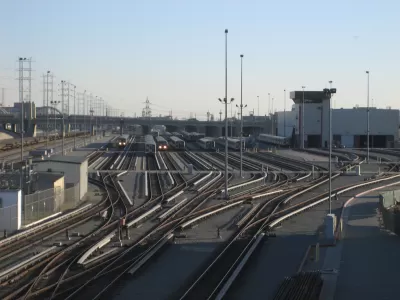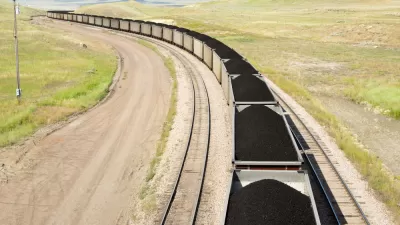Call it the Lac-Mégantic effect - the July 6 conflagration that leveled the downtown, killing 47 people, has implications for all jurisdictions where oil and freight trains run. Cities must recognize that rail insurance policies are woefully lacking.

When it comes to transporting hazardous material, rail has an advantage, perhaps more burden than blessing, over all other modes that pose significant risks for jurisdictions where the tracks are located.
Rail is the safest mode to transport these materials, which include a growing amount of crude oil and oil products. So safe that "(t)hey have a legal 'common carrier' obligation to haul cargoes that barge and truck lines can turn down," writes Betsy Morris. This testimony (page 2 of 21) in 2008 on behalf of the Secretary of Transportation elaborates on that obligation.
How safe is rail in transporting hazardous material? Curtis Tate of McClatchy's Washington Bureau explains in this Sacramento Bee article about California's preparation's to handle the more explosive Bakken crude.
The rail industry and its Washington regulators insist that railroads have a good safety record. The Association of American Railroads, an industry group, says 99.997 percent of hazardous materials shipped by rail reach their destination without incident. The Federal Railroad Administration, which oversees the nation's rail network, said 2012 was the industry's safest year on record.
The railroads are also liable for these hazardous shipments, and therein lies the problem. "There is not currently enough available coverage in the commercial insurance market anywhere in the world to cover the worst-case scenario," says James Beardsley, global rail practice leader for Marsh & McLennan Cos.' insurance brokerage unit.
Recently, “municipal leaders from Illinois, Vermont, Maine and New Brunswick toured Lac-Mégantic to assess risk to their own communities," writes Morris. "How does any community in America look at a cost like that and realistically think it can be covered? There's just no way," proclaimed Karen Darch, president of the village of Barrington, Ill.
As for who is paying the tab at Lac-Mégantic, where the clean-up cost alone is estimated at $200 million, Morris writes, "The train's operator, the Montreal, Maine & Atlantic Railway Ltd., had liability insurance of $25 million. That is about standard for a line of its size. The railroad has filed for bankruptcy protection. So far, the Canadian and provincial governments are picking up the steadily growing tab."
As bad as the devastation to Lac-Mégantic was, it was not a 'worst-case' scenario, as difficult as that may be to imagine.
"Your worst nightmare" is sabotage of a train carrying a toxic substance in a heavily populated area, says Says E. Hunter Harrison, chief executive of Canadian Pacific. "The estimates of the lives and the damage—I don't even want to repeat what it would be."
FULL STORY: Fiery Oil-Train Accidents Raise Railroad Insurance Worries

Alabama: Trump Terminates Settlements for Black Communities Harmed By Raw Sewage
Trump deemed the landmark civil rights agreement “illegal DEI and environmental justice policy.”

Study: Maui’s Plan to Convert Vacation Rentals to Long-Term Housing Could Cause Nearly $1 Billion Economic Loss
The plan would reduce visitor accommodation by 25% resulting in 1,900 jobs lost.

Why Should We Subsidize Public Transportation?
Many public transit agencies face financial stress due to rising costs, declining fare revenue, and declining subsidies. Transit advocates must provide a strong business case for increasing public transit funding.

Paris Bike Boom Leads to Steep Drop in Air Pollution
The French city’s air quality has improved dramatically in the past 20 years, coinciding with a growth in cycling.

Why Housing Costs More to Build in California Than in Texas
Hard costs like labor and materials combined with ‘soft’ costs such as permitting make building in the San Francisco Bay Area almost three times as costly as in Texas cities.

San Diego County Sees a Rise in Urban Coyotes
San Diego County experiences a rise in urban coyotes, as sightings become prevalent throughout its urban neighbourhoods and surrounding areas.
Urban Design for Planners 1: Software Tools
This six-course series explores essential urban design concepts using open source software and equips planners with the tools they need to participate fully in the urban design process.
Planning for Universal Design
Learn the tools for implementing Universal Design in planning regulations.
Smith Gee Studio
Alamo Area Metropolitan Planning Organization
City of Santa Clarita
Institute for Housing and Urban Development Studies (IHS)
City of Grandview
Harvard GSD Executive Education
Toledo-Lucas County Plan Commissions
Salt Lake City
NYU Wagner Graduate School of Public Service



























